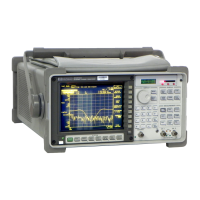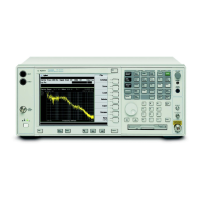Scaling the display
The arrow keys and the knob are especially useful in the [
Scale
] menu, since
they let you quickly change the vertical scaling.
Autoscaling Autoscaling lets the analyzer automatically select a vertical scale that best
fits the active trace. If autoscaling is left on, the analyzer adjusts the scale, if
necessary, each time the display is updated. If you prefer, you can select the scale
manually using the other softkeys in the [
Scale
]menu.
Keep in mind that autoscaling can affect a waterfall display. If the scale changes, the
analyzer clears the waterfall display and displays the next traces using the new scale.
This affects only the display, not the measurement. The cleared traces are still kept in
the waterfall buffer.
Scale references If you do not want to use autoscaling, you can select top, center, or
bottom scale reference. The analyzer keeps this reference, regardless of your choice of
y-units/division.
For example, if you are viewing frequency response data on the active trace, setting a
top reference of 20 dB means that the top of the line in the display graticule is always
at +20 dB. If you change the Y per div value, the top of the scale remains at +20 dB
and the bottom of the scale changes accordingly.
Input range tracking You can use input range tracking to reference the scale to the
input range currently in use. This behavior varies according to the trace coordinate
you’ve selected:
• For linear magnitude traces, the bottom reference always stays at zero. The Y per
div is adjusted so the top of the scale is greater than or equal to the current input range.
• For logarithmic magnitude and dB magnitude traces, the top reference always stays
at the current input range.
• For real and imaginary traces, the center reference always stays at zero. The Y per
div is adjusted so the top of the scale is greater than or equal to the current input range.
• Phase traces do not use input range tracking. Input range tracking is turned off
during an autoscale procedure or when you change the Y per div for real, imaginary,
or linear magnitude traces.
Input range tracking is not available when you display frequency response,
coherence, or math functions.
Agilent 35670A
Operator's Guide Setting Up a Measurement
Part I-19

